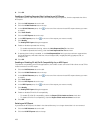
3. In the All NFS Exports pane, click in the row of the NFS export you want to delete.
4. Click Delete.
The Delete dialog box appears.
5. Click OK.
Enabling or Disabling NFS v4
NFS v4 is enabled or disabled on a system wide basis. By default, NFS v4 is disabled, which forces clients
to use NFS v3 and earlier. You might want to do this if you have clients that are incompatible with NFS v4.
1. Click the System tab on the left.
2. Click the Internal tab on the top.
3. In the Internal Settings pane, click .
4. Click Modify NFS Settings.
The Modify NFSv4 Settings dialog box appears.
5. Enable or disable NFS v4:
– To enable NFS v4, select the Enable NFSv4 check box.
– To disable NFS v4, clear the Enable NFSv4 check box.
6. Click OK.
Setting Permissions for an NFS Export
To assign user access to an NFS export, you must log in to the NFS export using a trusted client machine
account and set access permissions and ownership of the NFS export using the chmod and chown
commands on the NFS mount point.
Accessing an NFS Export
Clients use the mount command to connect to NFS exports using UNIX/Linux.
NOTE: The parameters are recommended parameters. See the mount command manual page in
the respective operating system for more information and other options.
Accessing an NFS Export with UNIX/Linux
To mount an NFS export folder from a shell on a client system, use the su command to log in as root and
run the following command:
# mount <options> <client_VIP_or_name>:/<volume_name>/<exported_folder>
<local_folder>
Accessing an NFS Export with UNIX/Linux Using NFS v4
To mount an NFS export folder and force the use of NFS v4 from a shell on a client system, use the su
command to log in as root and run the following command:
# mount –t nfs4 <client_VIP_or_name>:/<volume_name>/<exported_folder>
<local_folder>
Accessing an NFS Export with UNIX/Linux Using NFS v3
If NFS v4 is enabled on the FluidFS cluster, you can force a specific client to use NFS v3 if needed. To
mount an NFS export folder and force the use of NFS v3, from a shell on a client system, use the su
command to log in as root and run the following command:
109


















